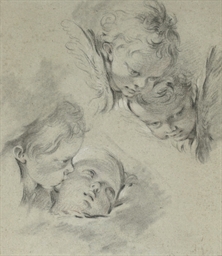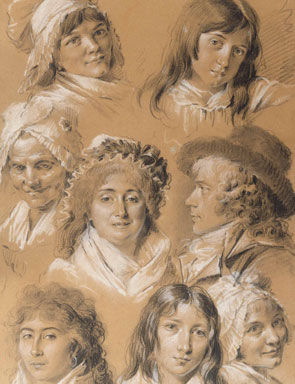Few eras in French history witnessed the same degree of radical social and political changes as those of the eighteenth century. The efflorescence of the ancien régime and its eventual downfall provide the backdrop to a period of remarkable artistic vitality and variety that subtly chronicled the many changes taking place in France. It is this dynamic period in French art history that was the subject of Rococo and Revolution: Eighteenth-Century French Drawings.
On view from October 2, 2009 through January 10, 2010 at The Morgan Library & Museum, the show featured more than eighty exceptional drawings almost exclusively from the Morgan’s renowned holdings from this era. Artists represented in the exhibition include Antoine Watteau, Jacques-Louis David, François Boucher, Jean-Honoré Fragonard, Claude Gillot, Nicolas Lancret, Hubert Robert, Pierre-Paul Prud’hon, Anne-Louis Girodet, and Pierre-Narcisse Guérin, among others.
The royal court and wealthy Parisian merchants defined the artistic sensibility of the century’s early decades. This exuberant style, called Rococo, eventually assimilated the burgeoning classicism of the Enlightenment. Later, with the triumph of “reason” and the stirrings of the Revolution, a more formally austere Neoclassicism developed.
The Rococo initially flourished during the waning years of the reign of Louis XIV (r. 1661–1715), and serves as a starting point for the exhibition. Works by artists active at the French Academy in Rome during its greatest years, coinciding with the rule of Louis XV (r. 1715–1774), documented drawing’s robust role in artistic practice during mid-century. The exhibition concluded with works executed during the last decades of the ancien régime, under Louis XVI (r. 1774–1792), and the onset of the Revolution, as artists embraced the rigorous Neoclassical style. Contextually, the exhibition also touched on concurrent developments in Parisian patronage, fashion, theater, and literature.
EXHIBITION HIGHLIGHTS
During the opening years of the eighteenth century, academic traditions yielded increasingly to a preference for spontaneity, charm, and subjects that celebrated the pleasures of love and everyday life. The first and greatest master of this new sensibility, later dubbed the Rococo, was Antoine Watteau (1684–1721).

Among the several Watteau drawings in the exhibition was a drawing of a seated young woman executed in trois crayons—a technique revived by the artist that would remain popular throughout the eighteenth century in which red, black, and white chalks are used to produce images of striking vivacity and immediacy.
The exhibition also included a lively pair of chalk figure studies by Nicolas Lancret (1690–1743), Watteau’s closest contemporary.
François Boucher (1703–1770), who succeeded Watteau as the most fashionable Rococo painter, was a prolific draftsman, once boasting that he had produced some 10,000 drawings. He favored a drawing style that emphasized sinuous contours, exploiting Watteau’s technique of using multiple chalks. Boucher’s technique and mastery of a variety of media are seen to brilliant advantage in

Adoration of the Shepherds, a richly worked, tender Nativity scene;

Four Heads of Cherubim, a quintessential study of cherubic heads for a painting;

Thatched Mill Cottage and Shed with Two Trees at the Edge of a Stream, a picturesque landscape;
and the sumptuously decorative Design for Frontispiece.
Drawings by Boucher’s contemporary and rival—and a key figure at the French Academy in Rome— Charles Joseph Natoire (1700–1777), included a dynamic figure study of a Camel Driver, and a pair of sheets depicting the picturesque views from the upper and lower portions of the cascade at the Villa Aldobrandinini, Frascati.
Jean Honoré Fragonard (1732–1806), Boucher’s and Natoire’s protégé, was the last great artist of the ancien régime. His works are notable for their engaging subject matter and seemingly effortless execution. Two attractive red chalk drawings of a young woman seated in a garden are from a series of sketches he produced of fashionably dressed young women.
Two lush landscape drawings by Fragonard—one in gouache,

Interior of a Park: The Gardens of the Villa d’Este

and the other in brown ink washes, Landscape, with Flock and Trees—
document his expert command of the brush and knowledge of the old masters.
The exhibition also included several exceptional landscape studies by Fragonard’s close friend and sketching companion, Hubert Robert (1733–1808). Among these works is an extraordinary sketchbook from Robert’s sojourn in Rome, containing several drawings depicting both actual monuments and architectural fantasies.
Gabriel de Saint-Aubin (1724–1780) worked almost exclusively as a draftsman and printmaker and was the great “society reporter” of pre-Revolutionary Paris. The show included his

small, vivid sketch of a demonstration in the Hôtel des Monnaies by the chemist Balthasar Georges Sage.
Also by Saint-Aubin is a

lively drawing of a ballet dancer dressed as Momus, the god of banter, holding a scroll advertising costume designs for a ball at the royal residence of St. Cloud.
The Enlightenment informed literature and the fine arts throughout the century. One of the most influential thinkers was Denis Diderot (1713–1784), author of the Encyclopédie. He was an advocate of rationalism and embraced the resurgence of classical history themes. In his reviews of the annual exhibitions known as the Salon, he reserved highest praise for the work of Jean-Baptiste Greuze (1725– 1805), whose life-size portrait of the philosopher is included in the show.
Jacques-Louis David (1748–1825), whose deft diplomacy enabled him to survive the Revolution and its aftermath, was France’s preeminent Neoclassical artist. David broke away from the Romanticism of his early works to define the new austere Classicism, both formally and iconographically. The exhibition featured an album by David containing eighty-three sketches, ranging from studies of antique sculpture to Italian landscapes, which was assembled in his studio by his sons. David’s sketches were an important source of inspiration for his paintings and document his close study of art and nature. A drawing of a quintessential Revolutionary subject, the Roman Brutus sentencing his sons to death:

"Brutus Returning Home after Having Sentenced His Sons for Plotting a Tarquinian Restoration and Conspiring against Roman Freedom; the Lictors Bring their Bodies to be Buried.
exemplifies the artist’s paradigmatic Neoclassical style.
David’s influence on eighteenth- and early-nineteenth-century draftsmanship was profound. Among his many pupils and followers was Anne-Louis Girodet (1767–1824). Girodet’s luminous and dramatic scene

Phaedra Confesses Her Love for Hippolytus to Oenone
was produced as an illustration to a volume of Racine’s classical themed plays, which were revived and embraced by the Neoclassicists.
The turbulent years of the Revolution (1789–1799), the heroic years of the First Empire (1804–1815), and the corresponding shift in patronage are reflected in the work of Pierre-Paul Prud’hon (1758– 1823). Prud’hon’s close association with Napoleon and Josephine is evident from his numerous portraits of members of the imperial household throughout his career.

Prud’hon’s sensitive portrait of a pensive Josephine and a depiction of the lush garden at her home at Malmaison are among the works produced for the empress during this period.
Rococo and Revolution: Eighteenth-Century French Drawings was organized by Cara Dufour Denison, Curator Emerita, Department of Drawings and Prints at The Morgan Library & Museum.
MORE IMAGES AND CREDITS

Etienne Louis Boullée (1728–1799)
Interior of a Library
Pen and black and some brown ink, gray wash, over traces of black chalk;
compass point at center; ruled borders in pen and black ink
(above)
Anne-Louis Girodet-Trioson (1767–1824)
Phaedra Confesses Her Love for Hippolytus
to Oenone
Pen and brown ink, brown wash, heightened
with white, over graphite
(above)
Gabriel Jacques de Saint-Aubin (1724–1780)
The Lesson of the Chemist Sage at the Hôtel des
Monnaies, 1779
Black chalk with some stumping and graphite,
point of brush and brown ink, gray wash, some
bodycolor
(above)
Pierre-Paul Prud’hon (1758–1823)
Study for a Portrait of Empress Joséphine, 1805
Black chalk, stumped in some areas, heightened with white, on
blue paper
9 3/4 x 11 7/8 inches (248 x 302 mm)

Hubert Robert (1733–1808)
Draftsman in an Italian Church, 1763
Red chalk
12 15/16 x 17 5/8 inches (329 x 448 mm)

Baptiste Oudry (1686–1755)
Rally at the Carrefour du Puits du Roi, Compiègne Forest, or The Booting of
the King for the Hunt, ca1733
Pen and point of brush and black ink and gray wash, over black chalk,
heightened with white, on blue paper faded to light brown
12 9/16 x 20 9/16 inches (213 x 522 mm)

Nicolas Hüet (1770–1828)
Study of the Giraffe Given to Charles X by the
Viceroy of Egypt, 1827
Watercolor and some gouache, over traces of black chalk
10 1/16 x 7 5/8 inches (254 x 194 mm)

Louis-Léopold Boilly (1761–1845)
Portraits of the Artist’s Family and Servants
Black and white chalk, on light brown wove paper
17 13/16 x 11 11/16 inches (450 x 297 mm)
(above)
Jean-Honoré Fragonard (1732–1806)
Interior of a Park: The Gardens of Villa d’Este
Gouache on vellum
7 3/4 x 9 1/2 inches (197 x 242 mm)

Louis Nicolas de Lespinasse (1734–1808)
View of the Banks of the Seine, Paris
Pen and brown ink and watercolor, heightened with white, over preliminary drawing in graphite
12 7/8 x 24 13/16 inches (326 x 630 mm)

Jacques Rigaud (1681–1754)
Les Dômes, 1730
Black chalk, pen and gray ink, gray wash
8 5/8 x 18 5/8 inches (220 x 473 mm)
(above)
François Boucher (1703–1770)
Adoration of the Sheperds, ca 1761–62
Pen and brown ink, brown and red wash, brown and black chalk,
heightened with white chalk, worked wet, over traces of black
chalk, on pink-prepared paper
11 3/8 x 14 5/8 inches (289 x 371 mm)
(above)
Gabriel Jacques de Saint-Aubin (1724–1780) Momus, 1752 Red and black chalk, with touches of white chalk 13 7/8 x 9 1/2 inches (353 x 242 mm)

Jean-Baptiste Greuze (1725-1805) Anacreon in His Old Age Crowned by Love,Pen and black ink, touches of brown ink, black wash, heightened with white tempera, over graphite, on brown paper, 314 x 407 mm, Bequest of Therese Kuhn Straus in memory of her husband, Herbert N. Straus; 1977.57
(above)
Antoine Watteau (1684-1721), Seated Young Woman, ca. 1716, Black, red, and white chalk, 255 x 172 mm, Purchased by Pierpont Morgan, 1911; I, 278a.

Jacques-André Portail, (1695-1759), Lady Sketching at a Table, Black and red chalk, brush and gray wash, with touches of pink and blue watercolor, 255 x 212 mm, Purchased by Pierpont Morgan in 1907; III, 98a.